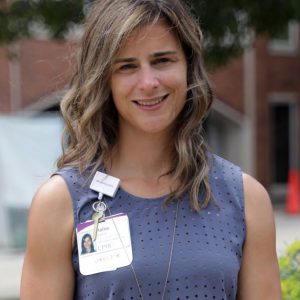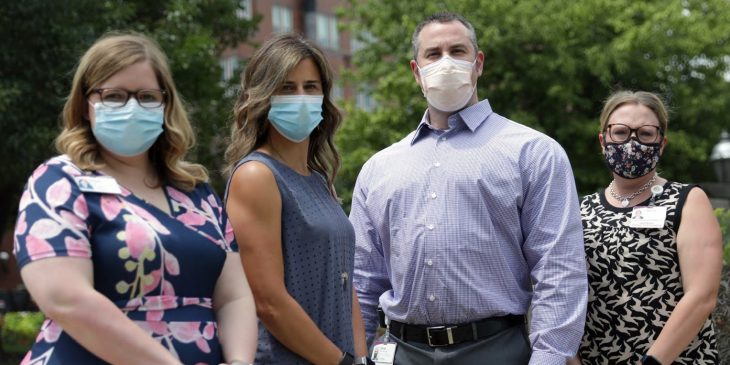Early this year, when the world was first coming to grips with the spread of COVID-19 and the challenges it would present, Dr. Brad Butcher, a critical care medicine specialist at UPMC Mercy, was focused on what was coming next.

Dr. Brad Butcher
“We heard that patients who required time in the intensive care unit, and particularly time on a mechanical ventilator, were staying on the ventilator for a very long time,” he said. “This is concerning because the longer people stay in bed, the more physical weakness can develop, and the longer they’re on ventilation, the more drugs they need to sedate them.”
Additional medication increases the risk of patients developing delirium, which raises the likelihood of long-term cognitive complications from the critical illness. These conditions would only be intensified by the limited interactions with care providers and loved ones permitted by COVID-19 safety protocols.
“We were very concerned that these patients would be at increased risk for anxiety, depression and post-traumatic stress disorder,” Butcher said.
In other words, COVID-19 had the potential to create a perfect storm in the realm where Butcher and his colleague Tammy Eaton, C.R.N.P., specialize: Post-Intensive Care Syndrome (PICS). PICS is a set of conditions that have been around as long as critical care medicine, but it received a name only a decade ago. Addressing PICS is the mission of the UPMC Critical Illness Recovery Center (CIRC), which Butcher and Eaton founded at UPMC Mercy.
Defining PICS
According to Butcher, PICS comprises “the physical, cognitive, psychiatric and social disabilities that can arise or worsen as a consequence of a critical illness and intensive care unit (ICU) stay.”
That can include muscle weakness, difficulty concentrating or remembering, anxiety, depression or post-traumatic stress disorder, among other challenges. PICS is generally associated with patients who ended up in the ICU due to a respiratory illness, sepsis or delirium. It is considered separate from the challenges faced by patients recovering from stroke or brain injury.

Tammy Eaton, C.R.N.P.
As Butcher and Eaton contemplated the idea of an ICU follow-up clinic at UPMC in 2016, there were few post-intensive care clinics in the country. As they began to talk with providers who were already doing the work, it became clear that UPMC Mercy, the flagship location of the UPMC Rehabilitation Institute, was the ideal location for UPMC’s program.
Butcher and Eaton developed a blueprint for the team they would need to involve, including pharmacy, physical therapy and respiratory therapy. They worked with leaders from the UPMC Centers for Rehab Services, who offered support in the form of a physical therapist, an occupational therapist and a speech pathologist to help spearhead the team’s work. Food and Nutrition Services provided a dietitian.
What was born was CIRC, a multidisciplinary program offered to those patients who are at risk for PICS upon discharge from the ICU.
What It Looks Like
A patient who leaves the ICU and is at risk for PICS will be screened and offered a follow-up visit with CIRC, which generally takes place two and four weeks after discharge. A full course of care comprises about four visits to the clinic over approximately one year.

Hallie Zeleznik
Patients can receive prescriptions for physical, occupational or cognitive therapy, or most commonly, all three. They also can be prescribed medication and educated on how to best manage their health after their illness. They may receive vital care, like vaccinations and smoking cessation treatment if appropriate, and might be provided tools like pill boxes to help them manage their medications.
Hallie Zeleznik, director, strategic initiatives and professional development, Centers for Rehab Services, helped develop the screening process along with Butcher and Eaton and recruited the team of therapists that works with CIRC patients.
The team also recently added a licensed clinical social worker, Anna Lewis, whose expertise in mental health allows her to schedule counseling sessions for patients and lead CIRC’s support group for former ICU patients.
Putting the Patient at the Center of the Team
One of the CIRC team’s goals is to change the way patients leaving intensive care look at their treatment plan — and their role in it.

Anna Lewis
“Patients are used to following the doctor’s orders,” Eaton said. “But we’re flipping the script a little bit, where they’re identifying what their goals are. Then we can actually model a treatment plan to meet that patient-centered goal.”
When patients are active and involved in creating their own goals, she noted, they are more likely to follow the treatment plan, ultimately leading to better outcomes.
The care team focuses on palliative care in relation to the symptoms many patients experience after leaving the ICU: pain, sleeplessness, anxiety and depression.
Helping COVID-19 Patients
If further spikes in COVID-19 hospitalizations do occur in UPMC’s communities, CIRC is ready, especially given the similarity of COVID-19 patients with others the clinic has already been seeing.
“By and large, we’re finding that these patients look very similar to other patients who have suffered any critical illness, particularly those with respiratory failure,” Butcher explained. However, there haven’t been enough COVID-19 patients yet to determine if any appreciable differences exist in contrast to the other patient populations the CIRC team treats.
COVID-19 “has generated a huge amount of interest in both what happens in the intensive care unit, which I think is what most people are focused on at the moment, but also what happens to patients once they leave the intensive care unit,” Butcher noted. “It’s really shone a light on the problems patients face after having survived a prolonged illness.”








